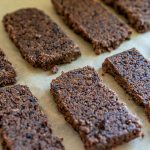 The aboriginal people of North America made pemmican by drying strips of buffalo meat or venison, pounding them with some berries into a powder, mixing the powder with melted fat, and then storing the resulting lump in a little bag made from the skin of the animal. Although early pioneers did not like the taste of pemmican, they recognized its nutritional value. First recorded in English in the early eighteenth century, pemmican derives from the Cree name for the food, pimihkaxn; this word in turn derives from two Proto-Algonquian words—pemy, meaning grease, and hkexw, meaning make.
The aboriginal people of North America made pemmican by drying strips of buffalo meat or venison, pounding them with some berries into a powder, mixing the powder with melted fat, and then storing the resulting lump in a little bag made from the skin of the animal. Although early pioneers did not like the taste of pemmican, they recognized its nutritional value. First recorded in English in the early eighteenth century, pemmican derives from the Cree name for the food, pimihkaxn; this word in turn derives from two Proto-Algonquian words—pemy, meaning grease, and hkexw, meaning make.
The given description refers to a type of sausage called “pemmican”. It is made of dried meat, typically beef (but formerly venison and bison were also used), that is pounded together with hot fat, dried berries, raisins, and suet. The mixture is then packed into a waterproof casing where it will keep indefinitely. Pemmican is very rich in food value, can be eaten with or without further cooking, and is still used during polar exploration due to its high-calorie content and long shelf life.
Obtained through the meticulous drying of buffalo or deer meat, this meat is finely pulverized into shreds and blended with melted fat. It serves as a concentrated sustenance, originally utilized by North American Indians and subsequently adopted by trappers and other explorers traversing the land.
